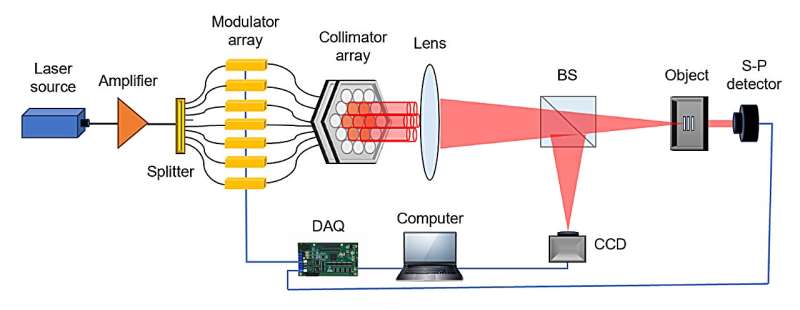This article has been reviewed according to Science X's editorial process and policies. Editors have highlighted the following attributes while ensuring the content's credibility:
fact-checked
proofread
Single pixel imaging enabled by fiber laser arrays is expected to achieve remote detection

Single-pixel imaging (SPI) is a novel computational imaging technique that has been widely studied in recent years. This technique only uses a single pixel detector without spatial resolution to obtain the spatial information of the target.
It has unique advantages making up for the lack of traditional imaging technology based on array detectors, such as remote sensing and non-visible light imaging, where the array detectors are relatively immature or more expensive.
The imaging speed of SPI is always limited by the refresh speed of spatial light modulator. For example, the typical digital micro-mirror device (DMD) has a max refreshing rate with 22 kHz at binary mode. This limitation makes it difficult to achieve real-time SPI.
Researchers led by Prof. Kai Han at National University of Defense Technology (NUDT), China, are interested in single-pixel imaging and fiber laser array. They propose an efficient scheme for SPI utilizing a phase-controlled fiber laser array and an untrained deep neural network.
Their study, "Efficient single-pixel imaging based on a compact fiber laser array and untrained neural network," was published in Frontiers of Optoelectronics.
The fiber lasers are arranged in a compact hexagonal structure and coherently combined to generate illuminating light fields. Through the utilization of high-speed electro-optic modulators in each individual fiber laser module, the randomly modulated fiber laser array enables rapid speckle projection onto the object of interest.
Furthermore, the untrained deep neural network is incorporated into the image reconstructing process to enhance the quality of the reconstructed images.
Given its potential for high emitting power (~ kW) and rapid modulation (~ MHz), the researchers predict that the SPI scheme is expected to be applied to remote sensing and target detection.
More information: Wenchang Lai et al, Efficient single-pixel imaging based on a compact fiber laser array and untrained neural network, Frontiers of Optoelectronics (2024). DOI: 10.1007/s12200-024-00112-8
Provided by Frontiers Journals





















